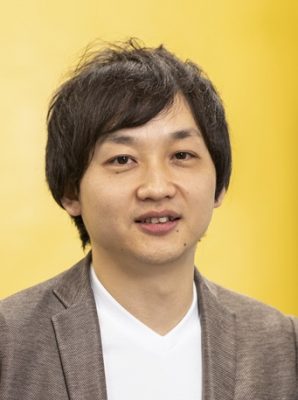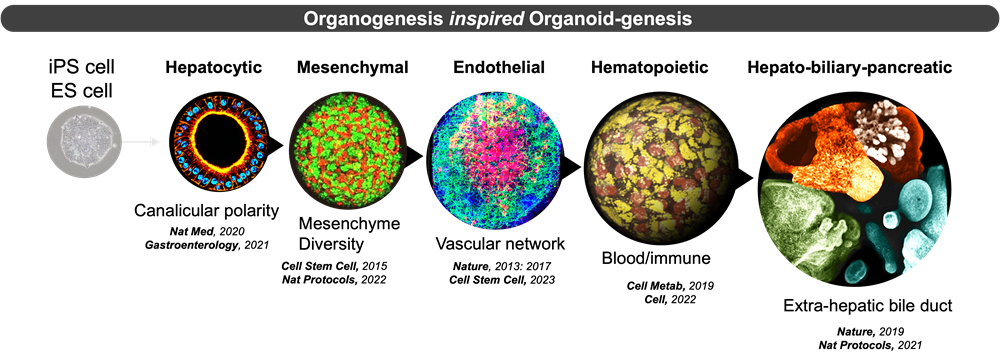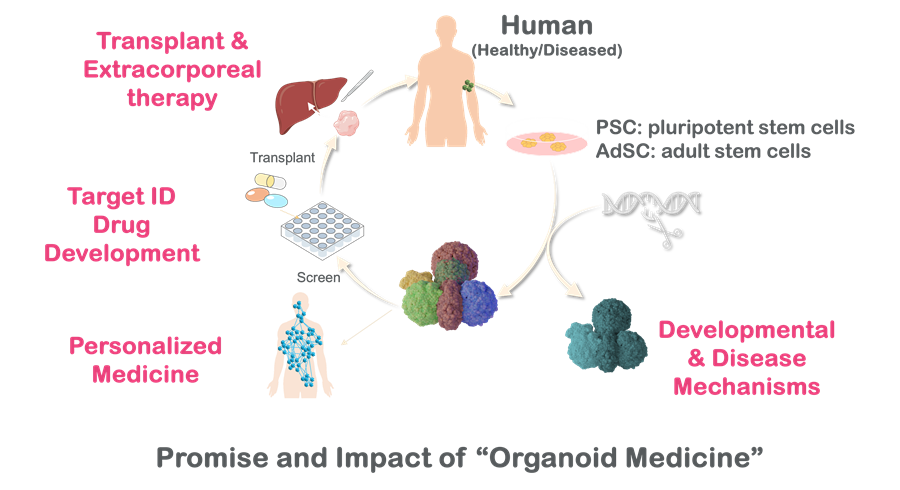Stem Cell and Organoid Medicine
Hope for Cure – Future of Precision Hepatology
- Synthetic human tissue systems grown from human pluripotent stem cells by translating the mechanisms of organogenesis.
- In a dish disease modeling system to advance disease mechanisms understanding towards drug discovery and development.
- Tissue replacement therapy for intractable liver diseases through the use of artificial organs and transplant medicine.
- We will transform precision medicine to uncover human disease diversity by combinatorial use of information science technology.

Learnings from Engineered Tissue Models for Personalized Cure
End-stage organ failure stands as a daunting terminal condition for numerous diseases, with transplant medicine often seen as the sole lifeline. Yet, the critical shortage of donor organs poses a significant challenge to this approach. In response to this pressing issue, our laboratory is at the forefront of pioneering research into the creation of three-dimensional artificial organs known as organoids, derived from human induced pluripotent stem cells (iPSC). Our journey began in 2013 when we reported the successful generation of a self-organizing liver bud organoids from human iPSCs marked a significant breakthrough. This discovery laid the foundation for a groundbreaking concept – the use of organoid transplantation as a means to alleviate liver failure. Our proof-of-principle success in mouse models resulted in several pioneering publications.

In hepatology, our lab seeks to understand how the living system creates interconnectedness across strata, how the interconnectedness plays a role in orchestrating tissue development and maturation, and how biological alterations in interconnectedness threaten our health. While investigations utilizing whole organisms have yielded valuable insights into the consequences of perturbations in biological connectivity from a top-down perspective, the mechanisms that drive these complex interactions remain largely elusive. Conversely, reductionist approaches employing cell-based models often lack physiological interconnectivity and are, therefore, oversimplified. To address this limitation, we have devoted our efforts to developing interconnected model systems across strata, which enable us to examine, manipulate, and infer the underlying mechanisms of interconnectivity at an unprecedented resolution.
Through the use of engineered human tissues equipped with inter-cellular, -tissue, -organ and -system crosstalk, we will replicate, analyze and control liver development and disease at personalized level. We will establish a unique preclinical human developmental and disease modeling platform with cutting-edge technologies including information science/artificial intelligence and intravital imaging. Our research program will provide a novel perspective on human liver disease, utilizing precision hepatology as a critical first step toward developing rational solutions for mechanism-directed diagnostic and therapeutic investigation.

【References】
1. Takebe T, et al. Nature, 499, 481–484, 2013.
2. Camp JG, et al. Nature, 546, 533–534, 2017.
3. Koike H, et al. Nature, 574(7776):112-116, 2019.
4. Takebe T, Wells JM. Science, 364 (6444), 956-95, 2019.
5. Kimura M, et al. Cell, 185(22):4216-4232.e16, 2022.
6. Kawakami E, et al. Cell Stem Cell, 30, 1315–1330, 2023.








